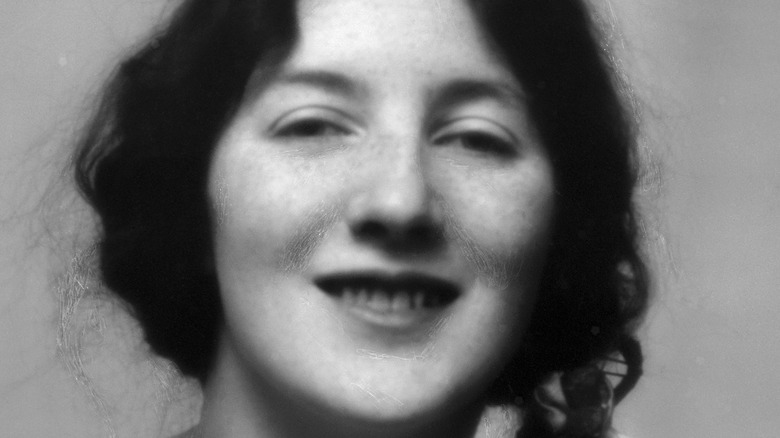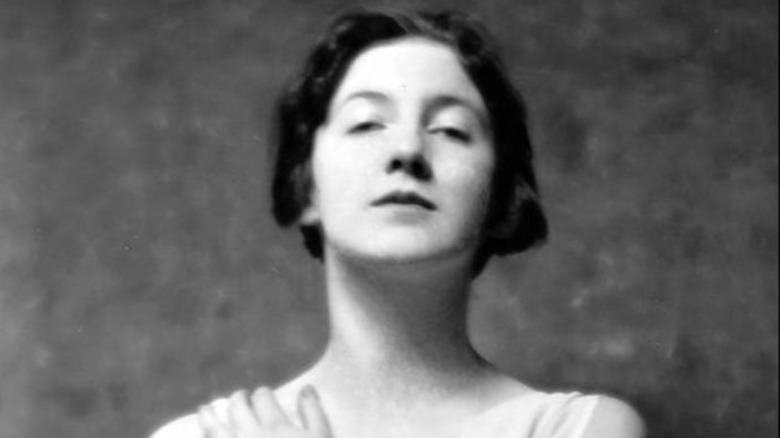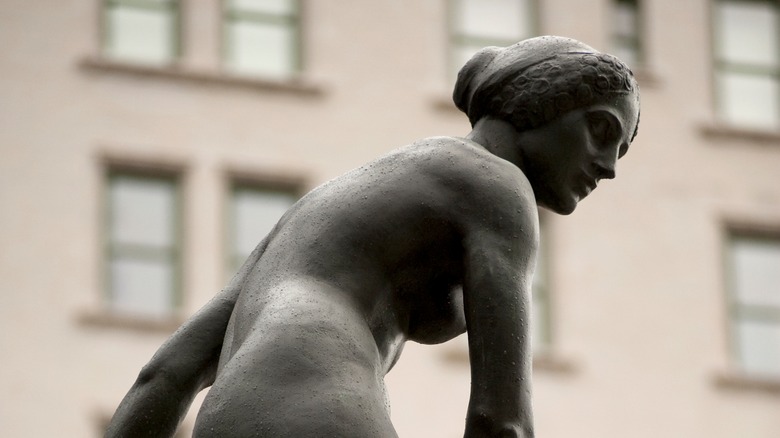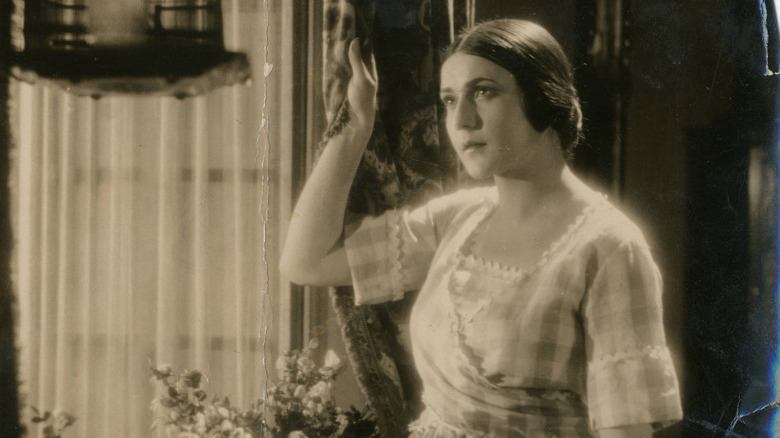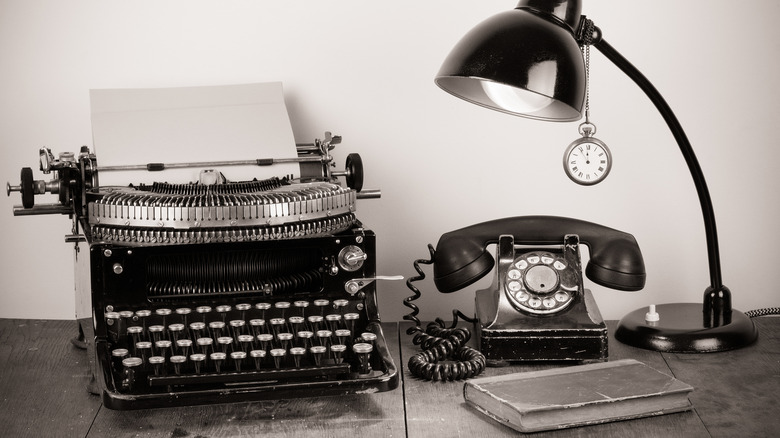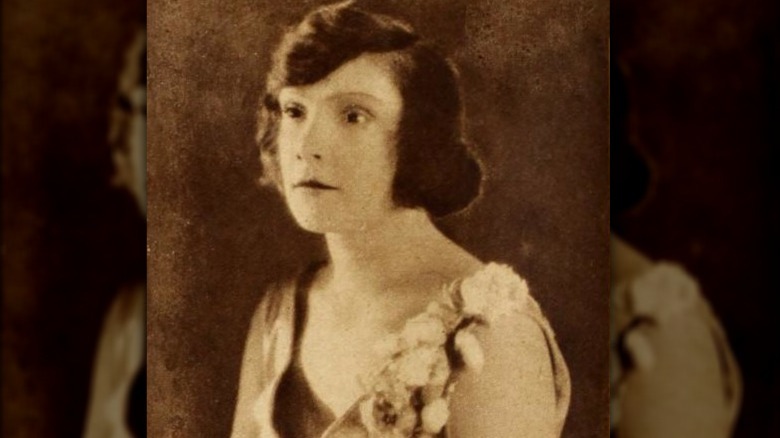The Tragic 1996 Death Of Audrey Munson, America's First Supermodel
Audrey Munson had it all — fame, looks, love, and money — and yet she died forgotten by the world, elderly, alone, and penniless. She was locked away for more than half her life, not even able to view the dozens of bronze and marble statues depicting her at the height of her career, that even today dot Manhattan from the Upper West Side to the entrance of the Manhattan Bridge to the West Side Highway to Columbus Circle, according to The Daily Beast.
Munson was America's first supermodel during the Gilded Age, an era that she came to embody, beginning in 1910, and later during the burgeoning age of cinema in the early 1920s, per Vogue. But Munson's life wasn't all glamour and glitz. From holding muscle-aching poses naked for hours on end in freezing studios while demanding artists yelled out commands, to dealing with an overbearing mother, her own mental health issues, and the press that both exalted her and then tore her down, Munson's struggles finally broke her by the time she hit 40, according to the New England Historical Society.
Audrey Munson had a hard upbringing
Audrey Munson was born in 1891 in Rochester, New York, to a father who was an itinerant real-estate speculator, according to James Bone's "The Curse of Beauty: The Scandalous & Tragic Life of Audrey Munson." Her mother, Kittie, raised Audrey by herself after divorcing when Audrey was 8 over her husband's philandering, per "The Curse of Beauty." They lived in boarding houses while Kittie put all her energies into her daughter. Kittie was perhaps one of the original stage mothers, that breed of parent who pushes their child hard towards the limelight. By the time Audrey was a teenager, she appeared in "Gerald Hampton's Dancin' Dolls" at an amusement park in Rhode Island, per the New England Historical Society, and then headed to New York.
Not long after her stage debut, when Audrey was just 16, the photographer Felix Benedict Herzog "discovered" her as she stood outside a Fifth Avenue millinery shop. She was wishing she could afford one of the extravagant hats on display, she recounted in a 1921 International Features Service article. He would introduce her to some of the most famous artists of the period, to whom she became a muse.
Miss Manhattan, American Venus, Exposition Girl
By 1915, Audrey Munson had posed for such famous sculptors as Gertrude Vanderbilt Whitney, founder of the Whitney Museum of American Art, and Daniel Chester French, who created the imposing sculpture of Abraham Lincoln for the Lincoln Memorial in Washington, D.C., according to Rediscovering Audrey by Justin White. There were so many sculptures of Munson in New York City, the press and public dubbed her "Miss Manhattan," per the New England Historical Society. In 1915, she became the main female model for the artwork featured throughout the World's Fair in San Francisco, dubbed the Pan-American Exposition. She graced three-fifths of the statuary, per a Richmond Times-Dispatch article from 1915 which crowned her the "Exposition Girl," making her the most famous artist's model in the world. She was also featured on a U.S. "Walking Liberty" half-dollar coin, per New Hampshire Magazine.
Munson was also described as "The American Venus" during the heyday of the Beaux arts movement in which artists, architects, and designers were obsessed with Greek and Roman forms and believed Munson's proportions perfectly encapsulated classic Grecian beauty, per Vogue. While male artists obsessed over her looks, Munson pushed boundaries for women. She refused to wear high heels or corsets, believing women's clothing should be more natural. She gave money to the suffragette movement, and pushed back on America's prudishness, according to The Daily Beast.
A new career in a new medium
After Munson had conquered the art world, she turned to a new medium, one which was less highbrow but was becoming popular and was even more about image: the moving image. Her first silent film, "Inspiration," came out in 1915 and featured the first non-pornographic scene with an naked woman in cinema history, according to Vogue. Munson, naturally, played an artist's model with several scenes in which she was au naturel, per the Wisconsin State Journal. This was a time before the Hays Code, which dictated what could and could not be seen on film. Her next feature, "Purity," was also a sensation but was banned by some prudish theaters.
Two more films would follow, "The Girl o' Dreams" in 1918 and 1921s "The Headless Moth," per IMDb. This would be her last film. A scandal back in New York in 1919 may have played into this. Producers replaced Munson, who was portraying herself in the film, with a look-alike actress for the non-naked scenes, per Rediscovering Audrey. The ensuing shakeup was enough to make her quit the film business.
Murder and scandal
Munson had lots of money and a slew of rich and well-connected bachelors throwing themselves at her. She was briefly engaged to Hermann Oelrichs, an heir to a vast silver fortune, but things were crumbling. Amid Munson's new film career, her former landlord in Manhattan, Dr. Walter Wilkins, brutally murdered his wife, per Rediscovering Audrey.
Wilkins, police learned, had become obsessed with Munson and the press ran with the story, falsely implicating Munson in the crime, according to the New England Historical Society. Munson and her mother went to Canada, where private investigators tracked them down and interviewed them. The authorities cleared Munson of any wrongdoing, but the bad press killed her career, according to the New England Historical Society. Munson's life soon spiraled downward as work dried up and the rich and famous who once courted her now deserted her. Munson and her mother moved back to Upstate New York, per Birth, Movies, Death. "The Wilkins case has ruined my life," Munson said afterwards, according to the Reading Times. "The public used to love and admire me. Now all I find everywhere is hate."
Audrey Munson's tragic end
Shortly after the Wilkins' murder scandal, Munson's mental health faltered. She became paranoid, writing a letter to the U.S. government alleging she was being persecuted by Jews, per Vogue. In 1920, a "bent, broken, hollow-cheeked" Munson attempted to persuade a newspaper to run her own death notice, according to the Buffalo Courier. She was trying to start her life over under a new name, but the clerk recognized her, per "The Curse of Beauty." Two years later she tried to kill herself, per Vogue, and by 1926 she was living in "a miserable little clapboard cottage on the outskirts of Syracuse, New York," walking "listlessly around and around" wearing "clothes that any farm woman might wear," according to The Spokesman-Review.
When Munson turned 40, her mother had her committed to St. Lawrence State Hospital for the Insane in Ogdensburg, New York, where she spent the next 65 years, per the New England Historical Society. After her parents died, she was utterly alone until two of her nieces discovered her in the 1980s, per Rediscovering Audrey. Audrey Munson died at the state hospital in 1996, at age 104, according to the New England Historical Society. When she was only a child, her mother had taken her to a fortune teller who told Audrey she would "be beloved and famous. But when you think that happiness is yours, its Dead Sea fruit shall turn to ashes in your mouth," per The Daily Beast. These words haunted Audrey Munson for the rest of her life.
